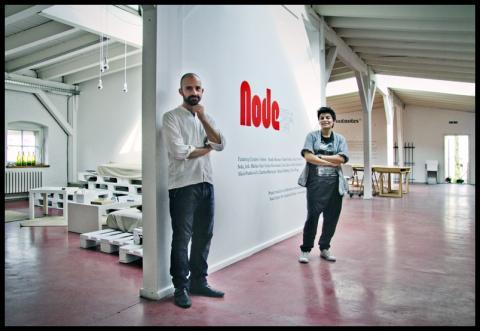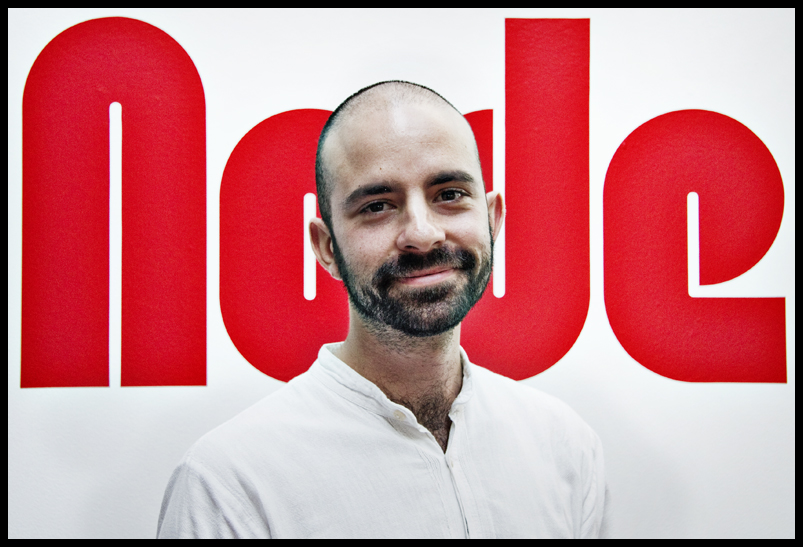Have You Met...Node Center for Curatorial Studies
Have You Met...Node Center for Curatorial Studies

Perla Montelongo and Ignacio Garcia from Node Center for Curatorial Studies (Image courtesy of Laura Gianetti)
Artists teaching Curators?
Perla Montelongo (Mexico, 1980) and Ignacio García Gómez del Valle (Spain,1978), founding members and directors of Node, both initially studied Fine Arts. Their paths crossed in Barcelona, during the masters program of Curatorial Studies and Cultural Practices in Arts and New Media at the MECAD Media Centre. Perla has previously lectured at the Escola Superior de Dissent while Ignacio has been the Chief Curator at the AlterArte Gallery. They first joined forces in the internet-based program Visions of Art. The first thing you notice about Perla and Ignacio is that they are extremely friendly and down to earth, maybe even a bit shy….
Node in Berlin
Node opened its doors in Berlin Kreuzberg in March 2011. The space is a cozy penthouse at Waldemastrasse 37A, and it can be visited by appointment. Amazing natural lighting, fabulous working desks, friendly design and a dynamic and professional staff is what is expecting the guests or any of the curators who get accepted in the three-month program. The over 100 square meter sized loft also includes a so-called lab for academic purposes and a lounge for presentations and talks. Temporary exhibitions organized by the residents are hosted here, but there is also regular portfolio viewings (apply online) and seminars open to the public. A quarterly publication sums up each working period. Unfolding, a series of exhibitions and an experimental publication organized by Node resident curators in collaboration with GRIMMUSEUM and Künstlerhaus Bethanien summarizes the practice of Node so far.

Perla Montelongo, Mexico/1980 (Image courtesy of Laura Gianetti)
What was the main concept behind your space, before you started?
Our idea was to create a space in which curators from different backgrounds and levels of experience come together to develop new projects and extend their networks. The program aims to reinforce curatorial practice by taking workshops and seminars, but mostly through practical experience and experimentation. But we also had crazy ideas. We designed some special dynamics to encourage our residents to experiment and take risks in their projects, to have a different perspective on what they normally would do in their previous practice.
How do you think the concept has changed/developed since then?
We readjusted the program according to the needs and profiles of our residents. We are strengthening the complicity between artists and curators during the development of the projects. We believe that inciting a closer dialogue between both sides will generate more interesting and risky proposals, so we'll keep this direction.
To what degree do you think you've reached your goals?
We intended to make riskier, less conventional activities, however we haven't dare to put them in force yet; for the first trimester we more or less adjusted the program to the curators. In future editions it might be more the other way around.... Some short-term goals like activities and proposals to engage curators deeper in the work of the artists were met.
How do you finance yourself?
On one hand thanks to the fee that our residents pay for the program, and on the other hand we invest our own money (earned with loads of effort). We'll start looking for additional funding possibilities in order to provide grants and to produce specific projects within the program.

Ignacio Garcia Spain/1978 (Image courtesy of Laura Gianetti)
What do you consider essential elements in curating a successful exhibition?
First: analyze which aspect you want to succeed. Second: never hesitate, have a clear intention and ask yourself if the work is pertinent within the context. It's also important to take into account all the components involved in an exhibition and to know the artist's works, needs and concerns.
Reflecting upon the time you have been running the space, what would you say you have learned about curating?
We're constantly learning, not only about curating, but also about managing a space. We learn from our residents, academic staff, and our relationship with institutions such as Künstlerhaus Bethanien or GRIMMUSEUM. Working together and observing their work is very inspiring. Every event we share is an opportunity to keep learning.
What are your favorite mainstream galleries in Berlin/ in the world?
Our favorite gallery is always the forthcoming one.
Do you have any favorite curators?
Alfredo, the projectionist of Cinema Paradiso (interpreted by Philipe Noiret), Quentin Tarantino, and Jorge Luis Borges.
Where will you and the space be in five years?
Since it's very difficult to predict our position in five years, we have asked the online crystal ball and Madame Poot, but the answers were a bit vague, ha ha ha...
If you had to describe your space in one sentence:
A space to collide people, ideas and projects.
If you had to describe your space in one word:
Node